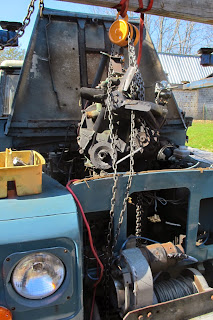Friday, May 15, 2015
In the clutch of desperation
Aimee went to work and left me alone with Roo yesterday, a normal occurrence. But what wasn't normal is I have a Land Rover with a bad clutch. Such things do not improve with age, so I very badly wanted to make progress on the repair, and the engine rebuild I decided must also happen -- if I'm to pull the transmission for a clutch, I might as well pull the engine for a clutch and a much needed full engine rebuild. All such things take time, and summer is short and I have a lot of other jobs to do.
Unfortunately Roo had other ideas, and woke right up from her morning nap after only half an hour, so I only made about an hour of total progress in the next seven hours until Aimee came home. I did lots of house cleaning, and all the shopping, grazed the sheep and fed the pigs and watered the plants and walked the dogs, but not the one important thing I'd planned to do. But then Aimee came home and I blitzed the rest, however yet again with my now-new-normal desperation to have something more substantial to show for a day's work.
I'm starting to really dislike this feeling.
This engine has been running fine for two years now on about a quart every thousand miles and 110 PSI compression, not to mention blue smoke each start-up from worn valve guides. As engine wear in old Land Rovers go, this is just about par for the course, and in the ordinary course, I would probably just put up with the oil usage and sluggish hill-climbing that results. But, if you're going to have to change a clutch, you may as well rebuild an engine.
I had decided to use the lift as a bridge crane to get this job done, tightly strapping blocks on each short front arm and a beam on top of the blocks, planning to roll the vehicle back once the engine was disconnected and lifted out of its engine bay. Although this worked well enough for the first part of the operation, it turned out to be a mistake for the second. Land Rover engines are deep. About thirty-eight inches deep, to be exact. I couldn't roll the vehicle back. You can see the problem in the next picture: the sump is still well below the top of the radiator housing.
In the end, I temporarily supported the engine on blocks inside the engine bay, dropped the hoist and beam, quickly turned the blocks under the beam the longer way around, replaced the beam and hoist, let some air out of the tires, and then was able to roll the Rover back with, however, not even an eighth of an inch to spare.
Even so, the operation was successful and the engine safely out. Satisfying, that. I had my supper and a beer and went to bed a happy man.
My next job will be to find some longer studs or blots to fit the motor to the engine stands. The ones that join the Rover's engine to the transmission are much too small. Then we'll blast the thing clean with degreaser and the pressure washer, then it will be time to strip down the engine and see what we've got.
Subscribe to:
Post Comments (Atom)






No comments:
Post a Comment
Welcome to our Farm Blog.
The purpose of this blog is for Aimee and I to communicate with friends and family, with those of our students, and other folks in general who are interested in homesteading and farming activities.
The earliest posts, at the very end of the blog, tell the story of the Great Farm, our purchase of a fragment of that farm, the renovation of the homestead and its populating with people and animals. Go all the way to the last post in the archive and read backwards from there to get it in chronological order.
After getting tired of spam comments (up to a dozen or more per day), I required commentators to be Google "registered users". You can write me at mwomersley@unity.edu if you have a serious comment or question and are not a registered user.
Spammers -- don't bother writing -- there's no way I will post your spam to my blog. Just go away.